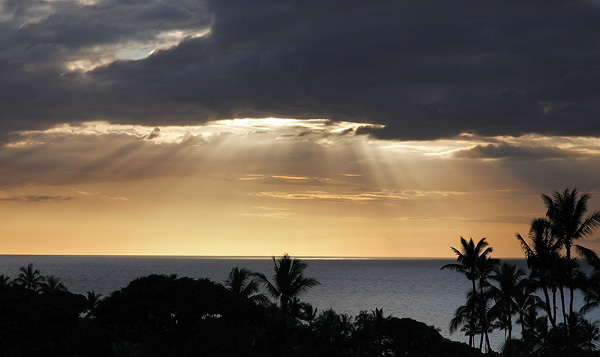My wife and I spent last week on the beautiful island of Maui. The Hawaiian Islands are one of our favorite places to relax and unwind, and there’s something about the lifestyle here that makes me feel at home. This trip started off great. We got a direct flight to Kahului and a few hours after leaving San Diego, we were dipping our toes in the tropical Pacific, with bellies full of fresh mahi-mahi.

I didn’t intend for this to be a photo trip, but I brought along my tripod in case an opportunity presented itself. For some strange reason, I had trouble sleeping the first night, so I decided to drive to Iao Valley State Park just before dawn. The road that leads to the park was gated, but I had my headlamp and was able to walk the final mile. I wanted to be there for sunrise, after all. There are lots of feral cats in Hawaii, and it was spooky as I hiked up the dark road, with so many pairs of eyes watching as I passed by.
Iao Valley is a sacred place to Hawaiians, and is the site of King Kamehameha’s final battle that would unite the entire island chain. Legend has it that hundreds of Maui warriors lost their lives in this valley, causing the river to run red with blood. I couldn’t help but contemplate the history and spirituality of the valley as I hiked up towards Iao Needle. The creepy cat’s eyes, watching silently, added to the mood.

It drizzled lightly as dawn approached. Low clouds hung over the valley, but they began to break apart as the sun crested the horizon. For just a moment, a wonderful golden light illuminated the entrance to the valley, while the mountains around me remained in deep shadow. A minute later, the light turned flat and lost all its drama. Turning around 180 degrees, I looked up towards Iao Needle, a lava-pinnacle that rises 1,200 feet from the valley floor. Surrounded by foggy mist, the needle looked very photogenic indeed.

My wife and I spent the next few days having fun in the sun, doing what most tourists do while visiting Hawaii. We hiked to some waterfalls, snorkeled with turtles, and sipped piña coladas while relaxing on our lanai. Each evening, we would find a nice vantage point to watch the sunset, and we were treated to some nice ones.

Wailea’s beaches don’t offer much in the way of interesting foregrounds, but sometimes, that’s just fine.


Things would change on Thursday evening. We were eating a late dinner and flipping through the TV when news of the earthquake in Japan broke. We spent the next few hours glued to the TV, watching the terrible events as they unfolded before our eyes. I felt a hit in the gut that reminded me of the way I felt as I watched the towers fall on 9/11. Even as I write this, nearly a week later, there could still be people who are trapped beneath the rubble, hoping to be rescued.

Around 11 pm, the evacuation sirens in Wailea started going off. Surprisingly loud, there was something very creepy about the siren as it wailed on and off through the humid night. We could hear the shorebreak crashing along the beach, and there was a strange mix of abstract danger and excitement. Was this really happening?
The tsunami was scheduled to arrive at approximately 3 am, so my wife and I decided to take the opportunity to drive to the summit of Haleakala for the sunrise. I had been there many years ago, and it is a sight to behold, despite feeling a bit like a tourist trap. It can get crowded, and it’s far from a wilderness experience. But, if getting to high ground was in order, Haleakala at 10,023 feet would probably be safe.

We arrived well before dawn, and it was very cold and windy at the summit. I wasn’t exactly prepared for this! Lacking warm clothes, I tripled up on board shorts and wore all four of the t-shirts I had available. We were high above the clouds, with a wonderful view of the clear, dark sky. The Milky Way was visible, and I believe the brightest “star” in the above image is actually Jupiter. The curved foreground isn’t due to lens distortion; it’s the bowl-shaped crater below the summit and silhouetted clouds in the distance.

This was a particularly sublime but solemn sunrise. The Pacific Ocean, obscured by clouds, was wreaking havoc below. There is awesome beauty and peacefulness in Mother Nature, and at times, gut-wrenching tragedy.

When the sun finally broke through the clouds, I felt a sense of optimism and hope.
A few hours later, we were back in southwest Maui. Driving into Kihei, there was a buzz in the air and you could tell that something was different. People were moving about and the beaches were empty. The main road was covered in mud and minor debris, and kids were scooping small fish out of a flooded park. There didn’t appear to be any real damage, though.
I wish I had spent more effort documenting this, but it didn’t really occur to me at the time. I walked around Kalama Park very briefly, taking some snapshots of the flooded areas. An eyewitness told me that the main road in Kihei “looked like a river” when the tsunami struck earlier that morning.


This is the seawall along Kalama Park. The waves breached this wall, flooded the park, and flowed along South Kihei Drive (pictured below).


We returned to San Diego the following day, with the people of Japan in our thoughts. These events remind me that the geologic forces which build the mountains and carve the canyons that I so love to photograph, are the same forces which are responsible for so much death and destruction. This is the reality of life on planet Earth.

